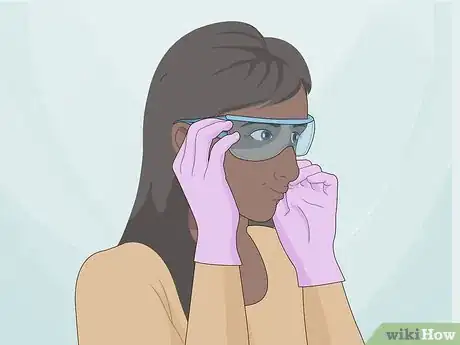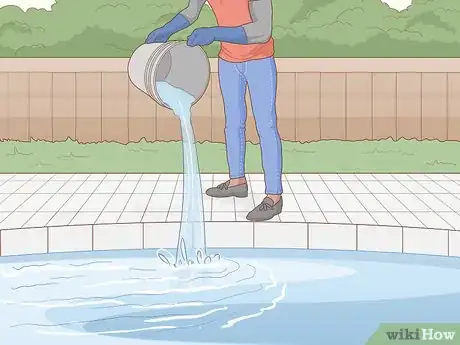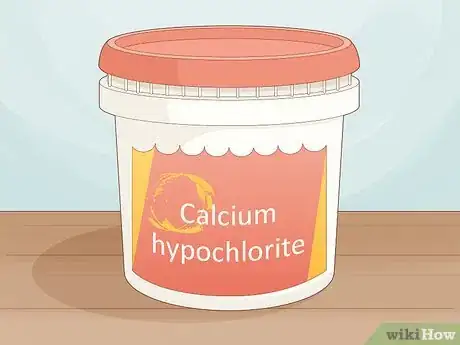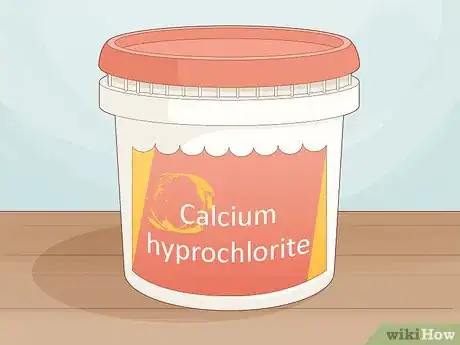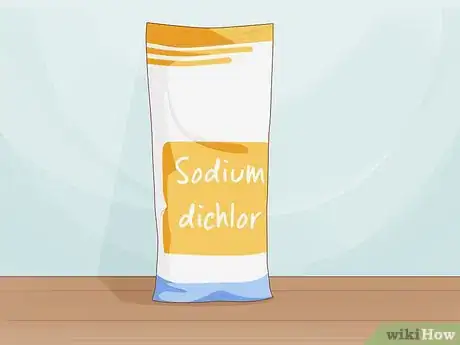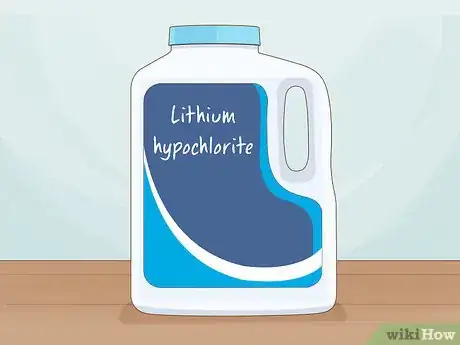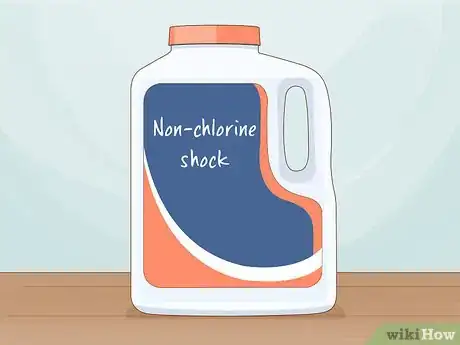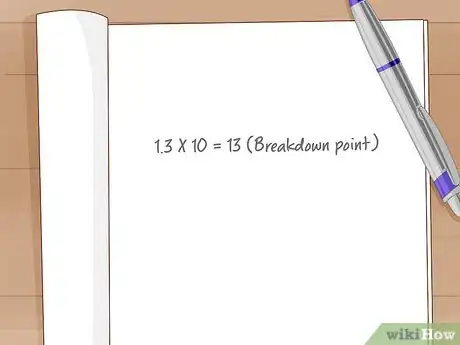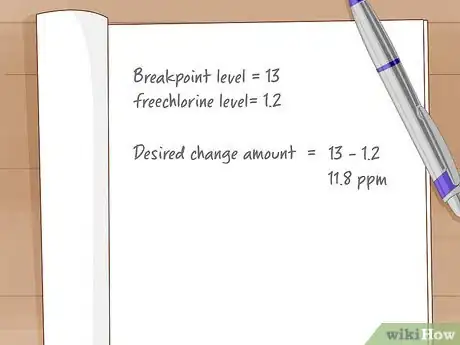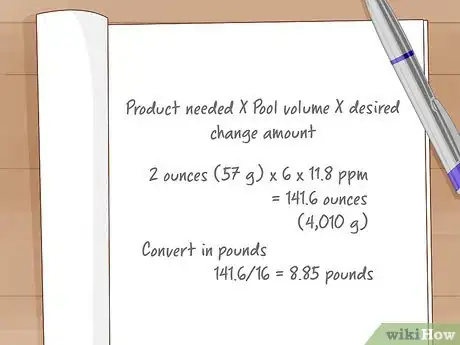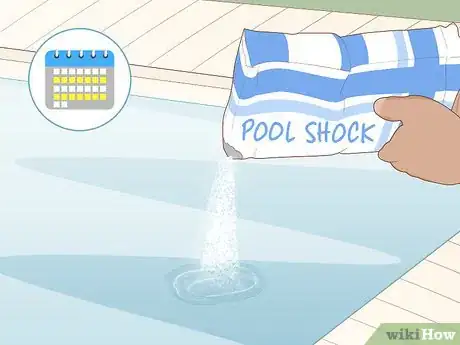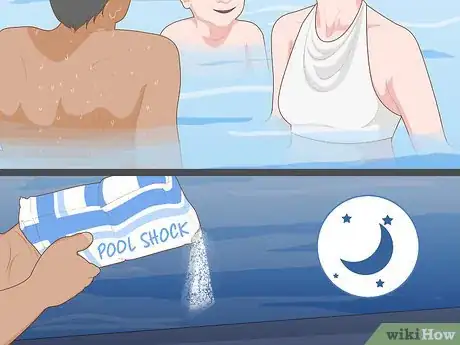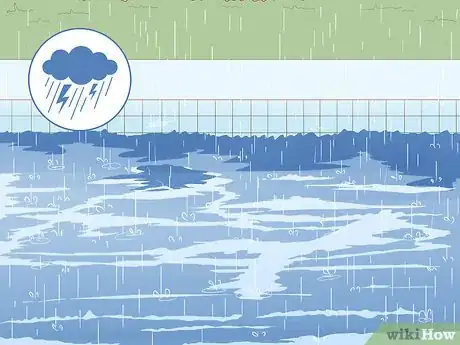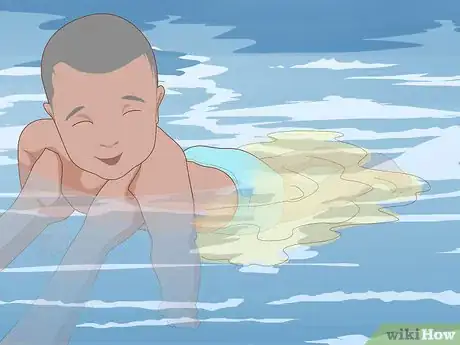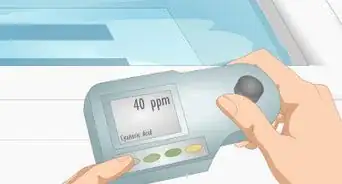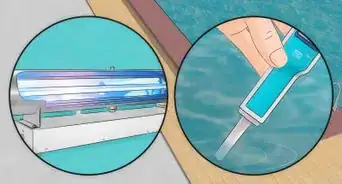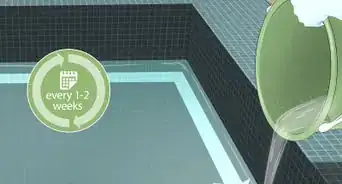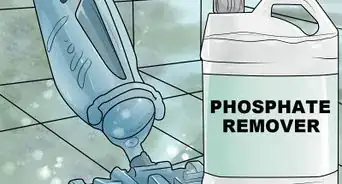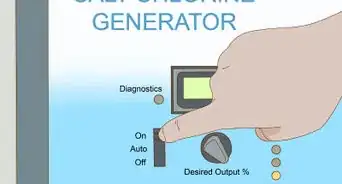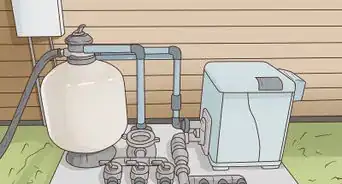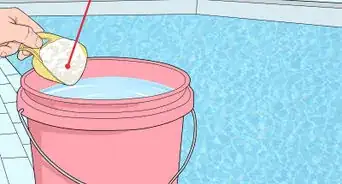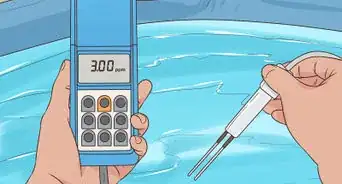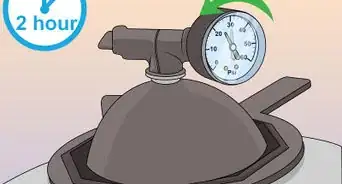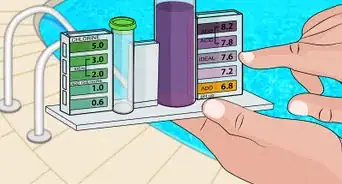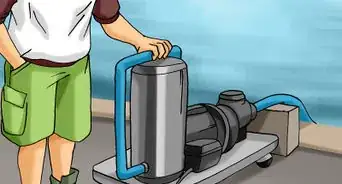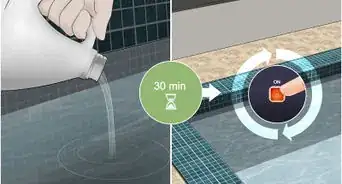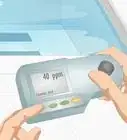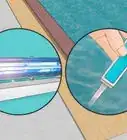This article was co-authored by wikiHow Staff. Our trained team of editors and researchers validate articles for accuracy and comprehensiveness. wikiHow's Content Management Team carefully monitors the work from our editorial staff to ensure that each article is backed by trusted research and meets our high quality standards.
There are 16 references cited in this article, which can be found at the bottom of the page.
wikiHow marks an article as reader-approved once it receives enough positive feedback. In this case, 100% of readers who voted found the article helpful, earning it our reader-approved status.
This article has been viewed 858,310 times.
Learn more...
Shocking, also known as super chlorinating, is a way to keep your pool safe and clean by adding a lot of chlorine to the water. By shocking the pool, you drastically raise the chlorine level for a short time to kill bacteria and sanitize the water. The process to shock your pool is easy, so get started on this important maintenance task right away!
Steps
The Shocking Process
-
1Wait until the sun is going down to shock the pool. Sunlight reacts with chlorine, so if you shock during the day, your free chlorine levels will be much lower. This won't clean your pool properly, so wait until the evening to shock.[1]
- If you have to shock during the day, use a chlorine stabilizer like cyanuric acid to preserve as much chlorine as you can.
-
2Put on safety goggles and gloves to protect yourself. Pool chemicals are harsh, and you definitely don't want any on your skin or eyes. Always wear protective gear when you're shocking the pool.[2]
- Don't breathe in the fumes from any of the chemicals you're using. They can cause irritation and choking.
- Also, wear long sleeves and pants to protect your skin from the chemicals you'll be using
Advertisement -
3Dissolve the product in 5 US gal (19 L) of water if it's granular. Some shocks come in a sandy or granular form. In this case, fill the bucket up two-thirds of the way with water. Add 1 pound (0.45 kg) of pool shock to the water, then stir it to mix it in. Go slowly so you don't splash the chemical on yourself.[3]
- Only mix 1 pound (0.45 kg) at a time. If you need more, do it a single bucket at a time.
- Never put the chemical in first. You risk splashing it out on yourself when you add the water.
- Skip this step if you're using a liquid shock.
-
4Pour the shock into the pool slowly as you move around the pool. Whether you're using a liquid product or one you need to mix bucket-by-bucket, add it by walking around your pool and pouring it in at different places. Pour slowly so you don't splash yourself with the chemical.[4]
- Make sure you don't get it on your skin. If you do, wash it off immediately, then check the back of the bottle to see if they recommend calling poison control.
-
5Wait a few hours before swimming. Usually, you need to wait at least 8 hours to swim, but the exact time varies depending on the product that you use. Read the bottle and follow the instructions provided so the chlorine isn't too strong.[5]
- Swimming in water with too much chlorine is very dangerous. Wait until the water reads 3 ppm or less when you test it using a DPD kit.[6]
- If you're using a non-chlorine shock, you may only need to wait 15 minutes before swimming.
Shock Types
-
1Pick calcium hypochlorite for a cheap, quick fix. This is the cheapest pool shock available. It dissolves quickly, and it's quite strong. However, it also doesn't last as long as most other chemicals, especially in sunlight, so you'll have to shock more often to keep your pool clean.[7]
- Always apply this type at night.
- This type is usually in granular form, so you'll need to dissolve it before adding it to the pool.
-
2Opt for sodium dichlor for a shock that lasts longer. This granular powder dissolves more slowly than calcium hypochlorite, meaning that it will keep working for longer periods in your pool. It also doesn't contain calcium, so it won't make your water harder.[8]
- Sometimes, you can add this directly to your pool without diluting it. It depends on the brand. When in doubt, dilute it in water.
- You should also add this one at night.
-
3Pick lithium hypochlorite if you have high calcium levels. This product also doesn't have calcium in it, so if you find your calcium levels are high through a test kit, this may be your best option. It also dissolves fast, so you don't have to dilute it beforehand, making application quicker and easier.[9]
- Lithium hypochlorite is getting expensive because of rising lithium costs, and manufacturers are cutting back their production. You might not be able to find this type.
-
4Choose a non-chlorine product to swim immediately. With most shock mixes, you have to wait up to 8 hours to swim in the pool again. However, non-chlorine products are safe to swim in after 15 minutes. Typically, they contain potassium peroxymonosulfate.[10]
- However, this will not kill algae like products with chlorine will. If you have green algae, choose a chlorine product instead.
Shock Amount
-
1Measure the free chlorine in your pool. To test the chlorine levels, you'll need a DPD kit. Dip the DPD test tube into the water at least 1.5 feet (0.46 m) to fill it up. Make sure the water reaches the fill line. Place a DPD #1 free chlorine tablet into the tube. Put the lid on and shake the tube until the tablet dissolves, changing the color of the water. Check the color of the water against the chart on the side of the tube, which measures from 0 to 5 parts per million (PPM). Write the reading down, because you'll need it for the next steps.[11]
- You can find these kits online or at pool supply stores; they measure how much chlorine is in the pool in parts per million (ppm).
- Some kits may use drops instead of tablets. Always read the instructions for your kit.
-
2Check the total chlorine in the pool. Open the test tube, but don't dump the water out. Using the same water in the tube, add a DPD #3 total chlorine tablet. Put the lid on and shake the tube until the tablet dissolves. Compare the color to the given chart, which will give the total chlorine in ppm.[12]
- Write down the total chlorine for your pool so you can run the necessary calculations.
-
3Subtract free chlorine from total chlorine to find combined chlorine. Combined chlorine is how much chlorine is mixed together. When the chlorine mixes like this, it's not as effective at disinfecting the water. To find your combined chlorine level, subtract the free chlorine from the total chlorine readings.[13]
- For instance, if your total chlorine is 2.5 ppm and your free chlorine is 1.2 ppm, your combined chlorine is 2.5 - 1.2 = 1.3 ppm.
- Your target for combined chlorine is less than 0.2 ppm.[14]
-
4Multiply combined chlorine by 10 to find the breakpoint level. The breakpoint level is how much chlorine you need to add to break up the combined chlorine in your pool and clean your water. The formula to find the breakpoint level is 10 times the combined chlorine, so multiply your calculation by 10.[15]
- If your combined chlorine level was 1.3, multiply that by 10 to get 13, your breakpoint level.
-
5Subtract free chlorine from the breakpoint level to find the desired change. The desired change amount tells you how much you want the water to change in ppm. That will guide how much chlorine you add to the pool. Figure it out by simply subtracting the free chlorine level from the breakpoint level.[16]
- For instance, the breakpoint level in the example is 13. Subtract the free chlorine level of 1.2 from 13 to get 11.8 ppm, the desired change amount.
-
6Divide the volume of your pool by 10,000 gallons (38,000 L). Typically, shock chemicals give an amount it takes to change the ppm level by 1 in 10,000 gallons (38,000 L). Therefore, divide the volume of your pool by 10,000 gallons (38,000 L).[17]
- For instance, if your pool is 60,000 gallons (230,000 L), divide by 10,000 gallons (38,000 L) to get 6.
- Always check your product for the correct amount.
-
7Multiply the divided pool volume by the amount of shock needed to raise the chlorine 1 ppm. Check the back of the bottle again. It will tell you how much you need of the product to raise the chlorine level by 1 ppm in 10,000 gallons (38,000 L). For instance, you may need 2 ounces (57 g) of the product to raise the pool by 1 ppm. Multiply that number by the pool volume number you found in the last step and the desired change amount.[18]
- In the example, that would be 2 ounces (57 g) x 6 x 11.8 ppm = 141.6 ounces (4,010 g).
- Divide that number by 16 to get pounds: 141.6/16 = 8.85 pounds.
When to Shock Your Pool
-
1Open and close your pool for the season with a shock. While your pool is closed for the winter, bacteria and algae can build up. Get rid of all that when you open your pool for the season with a good shock. Also shock the pool when you're closing it for the season to cut down on algae and bacterial growth during the winter.[19]
- If your pool is especially dirty when you first open it, give it a double shock to clean the water thoroughly.
-
2Shock your pool weekly for regular maintenance. Shocking is a normal part of pool maintenance. If you use your pool daily, then shock it once a week. That will help keep the water sparkling and clean every time you get in.[20]
- If you use your pool less often, then it's okay to shock it every other week. Don't do it less than that, though.
-
3Add shock after a lot of people use your pool. People can bring a lot of bacteria into your pool and knock the chlorine levels off. If you've had a pool party, for instance, shock your pool that night or the next day. That will help get rid of the excess human waste in the pool, such as skin, oils, and urine.[21]
- It doesn't have to be a big party. Even if you went in the pool with a few friends, still shock it.
-
4Shock the pool after big storms. Big storms with heavy rains can drastically change the chlorine levels in your pool and contaminate the water. Shock the water after a storm passed through to bring everything back into balance.[22]
- Even if you don't get a big storm, having rain for several days in a row can change your chlorine levels.
- Similarly, if your pool loses or gains a lot of water for any reason, it's time to shock your pool.
-
5Smell your pool and shock if there's a chlorine odor. Your pool shouldn't have a strong chlorine smell. If it does, that means your free chlorine levels are too low. Shock the pool to bring the levels back into balance.[23]
- A chlorine smell happens when chlorine combines with ammonia. When this happens, the chlorine is no longer "free," so it's not sanitizing your pool.
-
6Put shock in your pool if there's been a bowel-related incident. If a kid or an animal has left some feces in your pool, first clean that out. Then, add shock to the water, which will deal with the bacteria left behind by the feces.[24]
- If an incident like this happens at a pool party, clear the pool out and clean it right away.
Community Q&A
-
QuestionCan I shock during the day if I close the pool cover?
 Community AnswerAlthough you can, some chlorine will be destroyed by the sun's UV rays. You won't have the full effectiveness of the shock treatment. It would best if you do it under the shade followed by covering it. Covering the pool does help protect the chlorine for 2 days. It is best to do it at twilight hours in the evening.
Community AnswerAlthough you can, some chlorine will be destroyed by the sun's UV rays. You won't have the full effectiveness of the shock treatment. It would best if you do it under the shade followed by covering it. Covering the pool does help protect the chlorine for 2 days. It is best to do it at twilight hours in the evening. -
QuestionIf I open a portal into the return line from the pump, won't the pressure from the pumping water force water to spray out of the line? How would I add shock "into the return line" this way?
 Community AnswerDon't open anything - you pour the shock directly in the pool in front of the return so the stream carries it through the pool.
Community AnswerDon't open anything - you pour the shock directly in the pool in front of the return so the stream carries it through the pool. -
QuestionDose the pump need to be on when shocking?
 Community AnswerYes, it does keeping the water moving will help spread the chlorine and kill the algae -- hence the term shock.
Community AnswerYes, it does keeping the water moving will help spread the chlorine and kill the algae -- hence the term shock.
Warnings
- Always add chemicals to water, not the other way around. Adding water to chemicals can cause the chemicals to splash out of the container.⧼thumbs_response⧽
- Always wear the proper safety equipment, including protective goggles, when working with chemicals.⧼thumbs_response⧽
References
- ↑ https://dengarden.com/swimming-pools/Shocking-a-Non-Saltwater-Swimming-Pool
- ↑ https://www.swimuniversity.com/pool-shock/
- ↑ https://www.youtube.com/watch?v=-NVMTEnpUh0&t=48s
- ↑ https://www.swimuniversity.com/pool-shock/
- ↑ https://www.swimuniversity.com/pool-shock/
- ↑ https://www.cdc.gov/healthywater/swimming/residential/disinfection-testing.html
- ↑ https://www.poolcalculator.com/how-to-shock-a-swimming-pool-or-hot-tub/
- ↑ https://www.poolcalculator.com/how-to-shock-a-swimming-pool-or-hot-tub/
- ↑ https://www.swimuniversity.com/pool-shock/
- ↑ https://www.swimuniversity.com/pool-shock/
- ↑ https://www.youtube.com/watch?v=_2a8kGZKbgQ&t=21s
- ↑ https://www.youtube.com/watch?v=_2a8kGZKbgQ&t=42s
- ↑ https://www.in.gov/isdh/files/How_To_Shock_The_Pool.pdf
- ↑ https://www.swimuniversity.com/pool-shock/
- ↑ https://www.in.gov/isdh/files/How_To_Shock_The_Pool.pdf
- ↑ https://www.in.gov/isdh/files/How_To_Shock_The_Pool.pdf
- ↑ https://www.swimuniversity.com/pool-shock/
- ↑ https://www.in.gov/isdh/files/How_To_Shock_The_Pool.pdf
- ↑ https://youtu.be/3r7v3S1sRrU?t=97
- ↑ https://www.swimuniversity.com/pool-shock/
- ↑ https://dengarden.com/swimming-pools/Shocking-a-Non-Saltwater-Swimming-Pool
- ↑ https://dengarden.com/swimming-pools/Shocking-a-Non-Saltwater-Swimming-Pool
- ↑ https://www.in.gov/isdh/files/How_To_Shock_The_Pool.pdf
- ↑ https://www.swimuniversity.com/pool-shock/
About This Article
Before you shock your swimming pool, wait until after sunset so the UV rays won’t disrupt the process. Then, fill a 5 gallon bucket with water from the pool and slowly pour granular pool shock into the water. Stir up the mixture in the bucket and turn on the pool filter. Next, slowly pour 3/4 of the water into the pool. Refill the bucket with water, stir it to rinse out any residue, and then pour all of the water into the pool. Scroll down to learn how to keep the pool shock from settling to the bottom!

